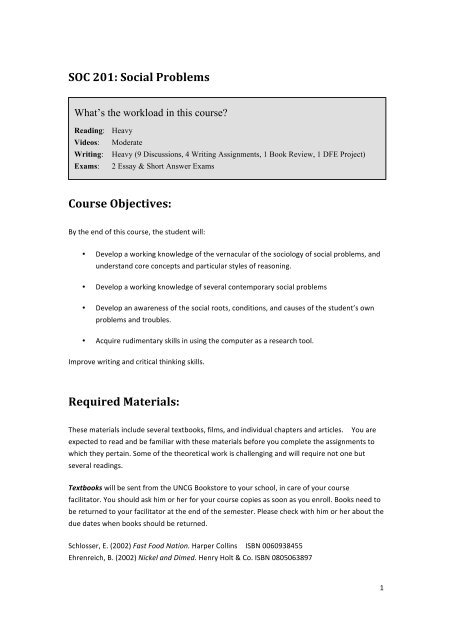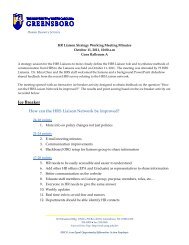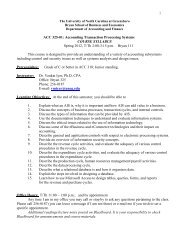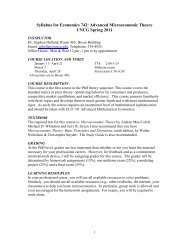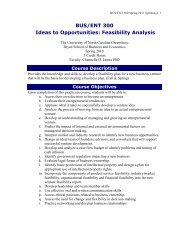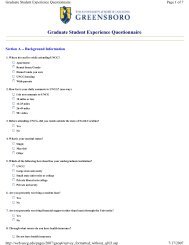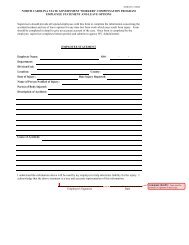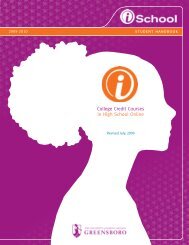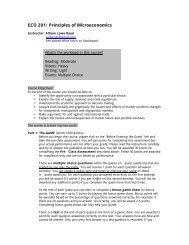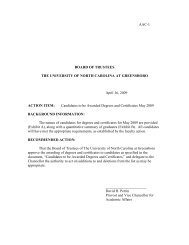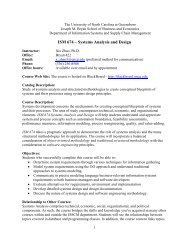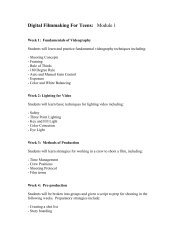SOC 201 Syllabus - The University of North Carolina at Greensboro
SOC 201 Syllabus - The University of North Carolina at Greensboro
SOC 201 Syllabus - The University of North Carolina at Greensboro
- No tags were found...
Create successful ePaper yourself
Turn your PDF publications into a flip-book with our unique Google optimized e-Paper software.
<strong>SOC</strong> <strong>201</strong>: Social ProblemsWh<strong>at</strong>’s the workload in this course?Reading: HeavyVideos: Moder<strong>at</strong>eWriting: Heavy (9 Discussions, 4 Writing Assignments, 1 Book Review, 1 DFE Project)Exams: 2 Essay & Short Answer ExamsCourse Objectives:By the end <strong>of</strong> this course, the student will:• Develop a working knowledge <strong>of</strong> the vernacular <strong>of</strong> the sociology <strong>of</strong> social problems, andunderstand core concepts and particular styles <strong>of</strong> reasoning.• Develop a working knowledge <strong>of</strong> several contemporary social problems• Develop an awareness <strong>of</strong> the social roots, conditions, and causes <strong>of</strong> the student’s ownproblems and troubles.• Acquire rudimentary skills in using the computer as a research tool.Improve writing and critical thinking skills.Required M<strong>at</strong>erials:<strong>The</strong>se m<strong>at</strong>erials include several textbooks, films, and individual chapters and articles. You areexpected to read and be familiar with these m<strong>at</strong>erials before you complete the assignments towhich they pertain. Some <strong>of</strong> the theoretical work is challenging and will require not one butseveral readings.Textbooks will be sent from the UNCG Bookstore to your school, in care <strong>of</strong> your coursefacilit<strong>at</strong>or. You should ask him or her for your course copies as soon as you enroll. Books need tobe returned to your facilit<strong>at</strong>or <strong>at</strong> the end <strong>of</strong> the semester. Please check with him or her about thedue d<strong>at</strong>es when books should be returned.Schlosser, E. (2002) Fast Food N<strong>at</strong>ion. Harper Collins ISBN 0060938455Ehrenreich, B. (2002) Nickel and Dimed. Henry Holt & Co. ISBN 08050638971
Kozol, J. (1996) Amazing Grace. Harper Collins ISBN 0060976997Chafe, W. (1990). Civilities and Civil Rights. Oxford <strong>University</strong> Press. ISBN 0195029194<strong>The</strong> film Supersize Me! will be made available via a link in the Announcements area two weeksbefore rel<strong>at</strong>ed assignments are due. Clicking on the link will take you to a page with the film insegments. You will need Flash Player to w<strong>at</strong>ch the film.<strong>The</strong> film Afterm<strong>at</strong>h: <strong>The</strong> <strong>Greensboro</strong> Massacre can be accessed by clicking the appropri<strong>at</strong>e linkin Assignments. If you have trouble viewing the film, ask your facilit<strong>at</strong>or for assistance.Individual book chapters and articles are available on e‐Reserves. <strong>The</strong> e‐Reserves area functionsas an electronic holding bin for these short readings. You have two ways to complete them. Youcan read each chapter or article directly on the screen. If your school policies and your facilit<strong>at</strong>orallow it, however, we strongly suggest you print them out on paper for easier reading,note‐taking, and reference.Unit 1:Chapters 1, 7, 8 and 10 from C. Wright Mills, <strong>The</strong> Sociological Imagin<strong>at</strong>ionUnit 2: From the “Class M<strong>at</strong>ters” series in the New York Times, David Cay Johnston, “Richest areleaving the rich far behind”.Unit 4: Chapters from Steve Kroll‐Smith, Phil Brown, and Valerie Gunter, (2000),Illness and the Environment. New York <strong>University</strong> Press. Balshem, Martha. Chapter 18: A cancer de<strong>at</strong>h. Brown, Phil, and Judith Kerwan Kelley, Chapter 3: Physicians’ knowledge, <strong>at</strong>titudes, andpractice regarding environmental health hazards. Quandt, Sara, Arcury, Thomas, Austin, Colin, Saavedra, Rosa. Chapter 11: Farmworkerand farmer perceptions <strong>of</strong> farmworker agricultural chemical exposure in <strong>North</strong> <strong>Carolina</strong>. Siskind, Janet. Chapter 9: An axe to grind: Class rel<strong>at</strong>ions and silicosis in a 19 th centuryfactory. Steingraber, Sandra. Chapter 17: Time.Units 3 & 5: No additional individual chapters or articles assigned.Course Activities:Required Course AssignmentsAll required course assignments must be completed before final grades are turned in.A. Book Review: Jon<strong>at</strong>han Kozol, Amazing Grace (170 points)Just wh<strong>at</strong> is a book review?2
Simply put, book reviews <strong>of</strong>fer readers potential inform<strong>at</strong>ion about books. Reviews <strong>of</strong> works <strong>of</strong>fiction generally <strong>of</strong>fer readers a synopsis <strong>of</strong> the book plot, a description <strong>of</strong> the characters, and anoutline <strong>of</strong> the membership <strong>of</strong> the intended audience. However, fiction and poetry are <strong>of</strong>tenwritten for the sheer beauty <strong>of</strong> language or with morality tales in mind. By contrast, socialscientific works <strong>of</strong> non‐fiction are pr<strong>of</strong>oundly uninterested in beautiful language or in art for itsown sake. Instead, sociological writing is there to <strong>of</strong>fer insight into some form <strong>of</strong> humanorganiz<strong>at</strong>ion. Specific theories are held up for examin<strong>at</strong>ion, and evidence is <strong>of</strong>fered to support orunmask the theories.Amazing Grace falls into the l<strong>at</strong>ter c<strong>at</strong>egory. It is your job to figure out wh<strong>at</strong> theoretical insightsKozol’s book <strong>of</strong>fers. You will read the entire book in the class. <strong>The</strong>n, answer questions about thereading and incorpor<strong>at</strong>e your answers into a coherent review essay. Be sure to include specificdetails <strong>of</strong> actual events th<strong>at</strong> occur in the book. Be also sure to incorpor<strong>at</strong>e wh<strong>at</strong> you havelearned from the course into your analysis <strong>of</strong> Kozol's work.By Friday, February 27 th , read the following two short papers listed under Course Documents:“Writing a critical book review”, and “Help for writing a book review”.<strong>The</strong> report should be <strong>at</strong> least three (3) and no more than five (5) pages in length. Both limitsare firm. Double‐space the review. Put page numbers in parentheses after a quot<strong>at</strong>ion. Save it inrich text form<strong>at</strong> (rtf). Submit it as a file <strong>at</strong>tachment. <strong>The</strong> header should include the author, title<strong>of</strong> the book, publisher, and d<strong>at</strong>e <strong>of</strong> public<strong>at</strong>ion. Your review must contain the following: a formalintroductory paragraph; the body <strong>of</strong> the paper consisting <strong>of</strong> a minimum <strong>of</strong> 4 to 5 paragraphswherein you answer the questions below using specific examples from the book; and a formalconclusion. You should use APA style and, because this is a formal paper, you must not use verbcontractions. Finally, your name should appear <strong>at</strong> the end <strong>of</strong> the review. <strong>The</strong> work must be yourown (i.e., do not use the internet!). Failure to follow these guidelines will result in points <strong>of</strong>fyour paper.Do not copy from book reviews online! Plagiarism is easily detected and WILL earn you a zeroon your review! We adhere to the Academic Integrity Policy <strong>at</strong> UNCG, and expect you to do soas well.Organize your review to answer the following set <strong>of</strong> questions:1. Wh<strong>at</strong> is the author's intention in writing this book? Wh<strong>at</strong>, in other words, does he or shewant to explain, interpret, or describe? Wh<strong>at</strong>, in yet other words, is the author's BIGquestion?Spend some time on this query. Try and grasp wh<strong>at</strong> Kozol is up to in this monograph.2. How does the author write this book? How, in other words, is the book organized? How,in yet other words, does the discussion proceed?3
3. Does the author succeed in answering the questions posed in the book? To begin with,are they worthwhile questions? Are they answered to your s<strong>at</strong>isfaction?4. Wh<strong>at</strong>, if anything, did the author ignore? Wh<strong>at</strong> might be added to make the book morepersuasive or readable?B. Tests (325 points total: Test 1 ‐ 150 points; Test 2 ‐ 175 points)Students will take two closed‐book exams. ALL EXAMS MUST BE TAKEN AT SCHOOL AND MUSTBE PROCTORED. Questions from quizzes (see below) may appear on the tests. <strong>The</strong> tests willinclude essay questions and questions in a short‐answer form<strong>at</strong>.C: Discussion Forums (9 discussion boards <strong>at</strong> 20 points each; 180 points total)Threaded discussions will occur throughout the course. Students are required to post to each <strong>of</strong>these discussions.Discussion boards are not free‐for‐alls. <strong>The</strong>y are places where ideas can be freely expressed andexamined. Your posts to the discussion boards need not be lengthy; however, they should benumerous and meaningful. St<strong>at</strong>ing your beliefs or opinions to a room, even an online ‘room’, is apresent<strong>at</strong>ion; only give‐and‐take can make it a discussion. But good discussions requireengagement, so write early and <strong>of</strong>ten. Write about your responses, both personal and academic,to the topics <strong>at</strong> hand. We expect th<strong>at</strong> in your discussion boards you’ll examine the m<strong>at</strong>erials,yourselves, and one another.Students will write two different kinds <strong>of</strong> posts to most discussion boards:responses.initial posts andInitial posts are students’ initial thoughts about the issue <strong>at</strong> hand. Generally, each post involveswriting a thoughtful answer to a question, a reading assignment, or a field activity. Due d<strong>at</strong>es foreach initial post are listed on the calendar as Post, which are worth 10 points each.Students must also respond to other students’ initial posts. <strong>The</strong>se responses form a crucial part<strong>of</strong> any discussion board. At a minimum, students should respond <strong>at</strong> least four times to eachdiscussion board. All responses on each board are together worth 10 points.All posts ‐ initial and responses ‐ must be posted before 4 pm on the due d<strong>at</strong>e to count. .Noteth<strong>at</strong> due d<strong>at</strong>es for different discussion boards overlap, so check your calendar <strong>of</strong>ten.D. Short Writing Assignments (4 assignments <strong>at</strong> 50 points each; 200 points total)You’ll find several short writing assignments assigned <strong>at</strong> various points throughout the course.Each <strong>of</strong> these should be tre<strong>at</strong>ed as mini‐essays. You can find a description <strong>of</strong> each writingassignment by clicking on the Assignments link in the left‐hand course menu.Unit 1: Narr<strong>at</strong>ive assignment: Your life as a social processUnits 2 & 3: No writing assignment4
Unit 4: Pellagra as a social diseaseUnit 5: Arab‐Americans on the race continuumAfterm<strong>at</strong>h: <strong>The</strong> <strong>Greensboro</strong> MassacreE. Documentary Film Editor Project (125 points)<strong>The</strong> DFE Project is assigned in Unit 2. This film project is a fun way for students to cre<strong>at</strong>ively showhow they understand some <strong>of</strong> the core concepts learned in Unit 2. <strong>The</strong>re is no need to filmanything; interviews, graphics, and text are provided for students. <strong>The</strong> assignment requiresstudents to select amongst the provided m<strong>at</strong>erials and cre<strong>at</strong>e a narr<strong>at</strong>ive to go along with theirselections. View the introductory video, then read the entire set <strong>of</strong> directions for the DFE.Doing so now will save you time <strong>at</strong> the end. You can find the introductory video by doing thefollowing:Course main menu ‐> DFE Projects ‐> Access for Documentary Film Editor 1 – Unit 2Decide on the bandwidth. If you’re unsure about the bandwidth <strong>of</strong> your computer, click on LowW<strong>at</strong>ch the video, then click on Continue to read the directions.A separ<strong>at</strong>e copy <strong>of</strong> the directions for completing the DFE can be found under CourseDocuments.Optional course assignmentsQuizzes (50 extra credit points possible; 25 points per quiz).Prior to each test, students can take extra‐credit quizzes. Each quiz can provide up to 3 points <strong>of</strong>extra credit on top <strong>of</strong> the final grade <strong>at</strong> the end <strong>of</strong> the semester. Quizzes cannot be retaken. ALLQUIZZES MUST BE TAKEN AT SCHOOL AND MUST BE PROCTORED. Quiz One is only availablebefore Test One, and Quiz Two is only available before Test Two. Quizzes should be understoodas self‐tests, since students are not penalized for poor results. For th<strong>at</strong> reason, students arestrongly encouraged to take both quizzes.Grading:Assessment:Students may earn up to 1,000 points during the semester.Amazing Grace Book review.....................................................................170 pointsExam 1.......................................................................................................150Exam 2.......................................................................................................175DFE, Unit 2................................................................................................125Writing assignments:5
Narr<strong>at</strong>ive assignment......................................................................50Pellagra as a social disease.............................................................50Arab‐Americans on the race continuum.........................................50Afterm<strong>at</strong>h: <strong>The</strong> <strong>Greensboro</strong> Massacre...........................................50Discussion posts.........................................................................................180Total..........................................................................................................10006


